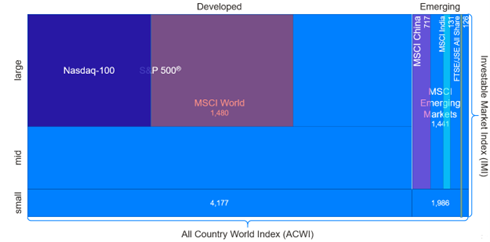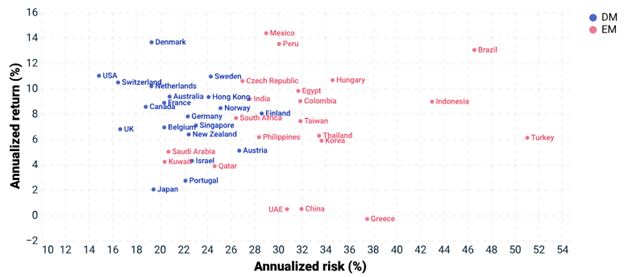Balance and diversification
The well-balanced MSCI All Country World Index (ACWI) captures opportunities by optimising on long-term returns, while also managing risk.
This index achieves this through broad market exposure, which also shields investors from concentrated risk, whether by market, region, or currency.
The MSCI ACWI includes both developed and emerging markets in one single index. The index is composed of large- and mid-cap stocks across 23 developed and 24 emerging market countries. With over 2 900 constituents, the index covers approximately 85% of the global investable equity opportunity universe, drawing diversified regional revenue, and can serve as a building block in investors’ overall asset allocation strategy. This index provides exposure to economies that may experience faster growth, yet higher volatility.
The below chart shows how broad the index is and how it compares to the universe of shares from other major indices.

To understand the opportunities in broad market exposure, the chart below shows the annualised returns of regions included in the MSCI ACWI, with data from 1988 to end of December 2023.

DM: Developed Markets
EM: Emerging Markets
There is also a clear difference in risk profiles, depending on the region, and a big dispersion in market returns. Rolling the dice by choosing only one or two regional exposures in the hopes of achieving high returns, while minimising capital loss, is a risk. Regional market returns can contrast each other, and this is where the MSCI ACWI index provides investors with a broader exposure – to all the opportunities within markets scattered across the chart.
Growth in different regions
In the above graph there is a clear indication of a difference in risk profiles, depending on the region, while there is a big dispersion in market returns as well. Frequent political turmoil, monetary policies, and volatile currencies can be attributed to emerging markets being on the higher end of the risk scale. However, these regions provide a diversified and entirely different opportunity set compared to developed markets.
An interesting example of this is the luxury-led French market (developed) in comparison to South Africa’s resources-led market (emerging); each with their own factors, opportunities, and limitations.
The International Monetary Fund has revised its growth estimates for Asia, with China and India accounting for most of the upward revision. The MSCI All Country World Index provides investors with an opportunity to diversify across traditional developed market regions and high-growth emerging market regions. Over 60% of its exposure comes from its US constituents, which generate around 45% of its revenues. China accounts for 10% of revenue exposure, with Japan at 5%. India comes in at 3% and South Korea at 3% as well.
The Satrix MSCI ACWI ETF
Investors looking to access the broad range of companies from developed and emerging markets within a single fund can do so via the new Satrix MSCI ACWI ETF that listed on the JSE main board on 22 February 2024. This local ETF offers an efficient and low-cost investment that captures thousands of stocks across many jurisdictions, all in a single trade. The fund is non-distributing, with a TER of 0.35%, and is priced in rands.

SatrixNOW is a no-minimum online investing platform from Satrix that allows you to buy and sell ETFs directly.



